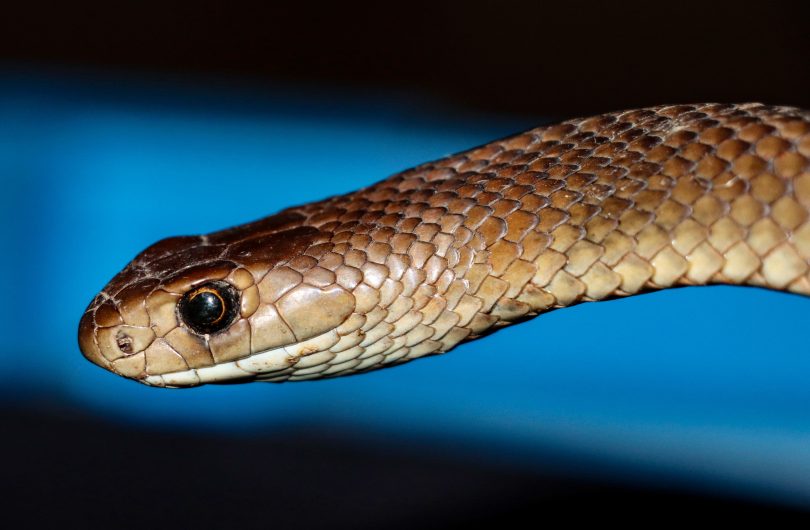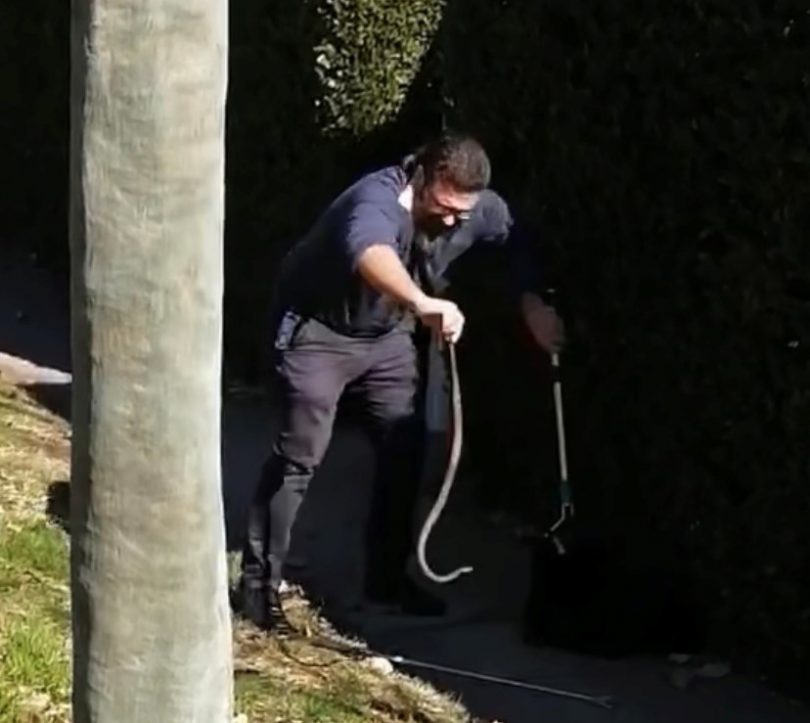
The eastern brown is the most common snake species in the ACT. Photo: Canberra Snake Tracking Project.
As the daylight begins to last longer and the first blossoms pop out, there’s another sign from nature that spring is on the way: snakes.
The first snake of the season was an eastern brown (Pseudonaja textilis) caught in Yarralumla on 10 August, making it the earliest on record for Canberra.
The slithering, cold-blooded reptiles emerge from their winter hidey holes in search of warmth and food, but Alex Borg from the Canberra Snake Tracking Project says a mild winter and an early spring are clearly bringing some out early.
“We aren’t entirely surprised that some snakes were active for a short time, with bright sunshine and ambient temperatures hitting approximately 15 to 16 degrees Celsius,” he said.
“Our tracking work reveals that one of our research snakes in the Mount Taylor Nature Reserve recently moved around 240 metres from one hibernaculum to another. That said, some of our other tracked snakes have not moved burrows or been active since April – one of the reasons why it’s tricky to make hard and fast universal rules about these guys’ behaviour.
“We have caught other snakes earlier in the year, but these were ones that were disturbed during excavation or construction work. This one was actually moving around to get some sun and sniff out some food.”
Alex and his Canberra Snake Tracking Project colleague, Gavin Smith, can tell when snake season begins each year because the number of calls to catch them from residents increases.

This eastern brown snake was caught while out for a slither in Yarralumla. Photo: Andrew Pratt.
The large ones are taken back to their facility, where they are measured and weighed, fitted with a tracking device, and released back into the wild.
For the smaller snakes, Alex and Gavin record various biological measurements and microchip them. Then, if they are re-caught at some future date at another location, they are able to determine how much they have grown, and compare the growth rates of males and females that have been released into different habitats.
“Taking scale clippings and putting the microchip in them is a bit of a stressful event [for the snakes],” says Alex. “But we try to make it as quick and as stress-free as possible, and then swiftly release the animals back into appropriate habitats in as optimal conditions as possible.
“Today is a bright and sunny day so we’re going to release her so she can go out and find a new hole to live in.”
Alex and Gavin began the task of tracking Canberra’s snakes because they wanted to know what happens after one is caught and released into a different habitat.
“What do they do? Where do they go?” says Alex. “Is it genetic diversity among the individual populations in Canberra that we’re potentially mixing up? Are we doing the snakes a disservice by catching them and moving them too far away, potentially giving them a death sentence?”
The duo has gone on to bust plenty of myths surrounding snakes.

An eastern brown snake caught in the act. Photo: Andrew Pratt.
“We’ve caught snakes, relocated them two kilometres away and then in a matter of weeks they’ve travelled back to where we’ve caught them,” says Alex. “We’re called out to catch them again, and then they might return to the same street, but not the same house.
“This is bad news for the house owner, but good news in that the snakes have evolved to live with humans because we’re dirty creatures and we attract mice, and snakes love mice.
“A widespread perception is that snakes in Canberra disappear entirely over winter, but this isn’t always the case for every snake. While it is certainly uncommon to discover brown snakes out and about this time of year here, if the environmental conditions are right, some may intermittently appear to bask or to complete short journeys from one burrow to another.”
Alex says snake numbers during the years have been fairly steady, with only mild fluctuations.
“Similar to last year, snake season might start early, but it might finish earlier as well,” he says. “We have very human perceptions of what the seasons are, but the animals go off different signs. They’re so in-tune to little things that we don’t fully understand yet.
“We definitely need to learn a lot more from them – things that could help humans with crop plantings and so on.”














